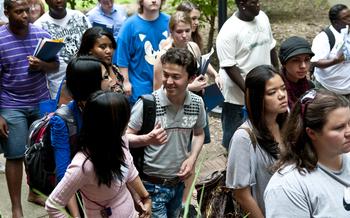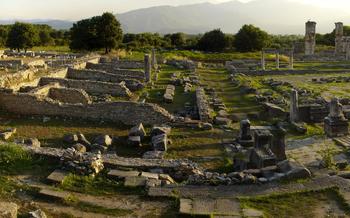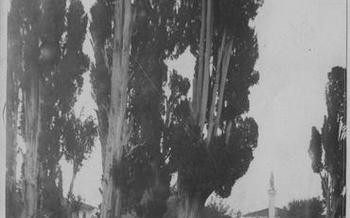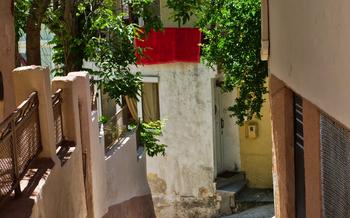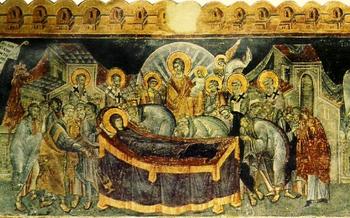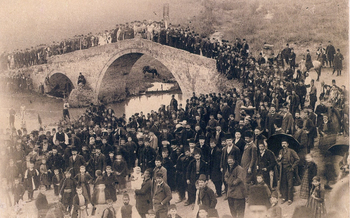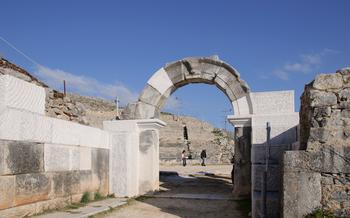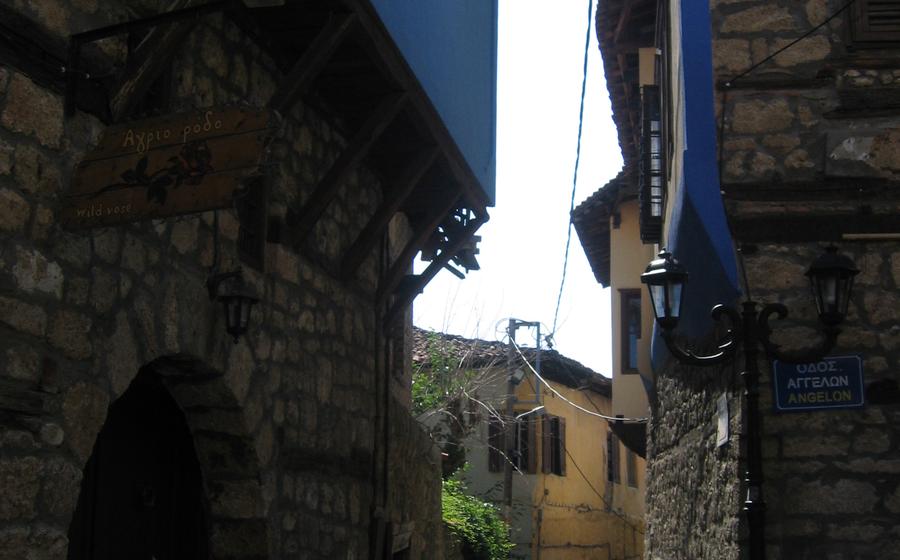
The Step of Apostle Paul
- The Apostle Paul's Legacy
- Unveiling the Step of Apostle Paul
- Exploring the Archaeological Site
- A Place of Pilgrimage
- The Apostle Paul's Stay in Veria
- The Jewish Community of Veria
- The Synagogue of Veria: A Glimpse into Jewish History
- The Archaeological Museum of Veria
- Local Traditions and Celebrations
- The City of Veria
- Transportation and Accessibility
- Accommodations and Amenities
- Etiquette and Cultural Sensitivity
- Photography and Videography: Capturing the Essence of Faith
- Insider Tip:
The Apostle Paul's Legacy
The historical significance of Saint Paul's missionary journeys cannot be overstated. As one of the most prominent apostles of the early Christian church, his travels and teachings had a profound impact on the spread of Christianity throughout the Roman Empire. His letters, known as the Pauline epistles, form a significant portion of the New Testament and continue to shape Christian theology and practice to this day. Paul's teachings on faith, grace, and redemption revolutionized the understanding of the Christian message, emphasizing the universal nature of salvation and the importance of personal belief rather than adherence to strict religious laws. His legacy as a tireless advocate for the Christian faith and a bridge-builder between different cultures and communities continues to inspire and guide believers around the world.
Unveiling the Step of Apostle Paul
Nestled in the heart of Veria, a city steeped in historical significance, lies the revered Step of Apostle Paul. This sacred site, believed to bear the imprint of the apostle's foot, holds immense spiritual importance for Christian pilgrims and history enthusiasts alike. Its discovery, shrouded in mystery and intrigue, adds to the allure of this ancient relic.
The exact origins of the step remain shrouded in the mists of time, but local legend attributes its revelation to a remarkable dream. In the 19th century, a pious woman experienced a vivid vision in which the apostle himself guided her to the site of his footprint. With unwavering faith, she embarked on a quest to unearth the sacred relic, and her efforts were eventually rewarded with the discovery of a stone bearing a distinct indentation resembling a human foot.
The significance of this discovery cannot be overstated. According to Christian tradition, the step marks the spot where the Apostle Paul, during his second missionary journey, delivered a powerful sermon to the Jewish community of Veria. His words, filled with wisdom and conviction, resonated deeply with many, leading to the establishment of a thriving Christian community in the city.
The Step of Apostle Paul stands as a tangible reminder of the apostle's transformative presence in Veria. Its enduring legacy serves as a beacon of faith and devotion, drawing countless visitors to this sacred site to experience the profound spiritual connection to one of Christianity's most influential figures.
Exploring the Archaeological Site
The discovery of the Step of Apostle Paul sparked extensive excavations, uncovering a wealth of historical treasures. Archaeologists meticulously unearthed the ruins of ancient buildings, revealing the foundations of a once-thriving city. Among the most significant findings was a well-preserved Roman road, believed to have been the path that Paul himself walked during his time in Veria.
The integration of the step into the existing urban landscape showcases the harmonious blend of history and modernity. The ancient relic stands proudly in a purpose-built enclosure, surrounded by contemporary architectural elements that complement rather than overshadow its significance. Visitors can freely walk around the site, marveling at the intricate details of the step and imagining the apostle's presence.
The architectural features of the site speak volumes about Veria's rich past. The stone-paved streets, the remains of public buildings, and the intricate mosaics provide glimpses into the daily life of the city during the Roman era. Visitors can trace the footsteps of history as they explore the archaeological site, piecing together the puzzle of Veria's ancient heritage.
A Place of Pilgrimage
The Step of Apostle Paul in Veria has become a significant pilgrimage site for Christians and history enthusiasts worldwide. Pilgrims from various denominations and countries flock to the sacred site to pay homage to the apostle's legacy and seek spiritual enlightenment. The site holds immense religious significance for those seeking a deeper connection with their faith and a chance to retrace the footsteps of one of Christianity's most influential figures.
For religious visitors, the opportunity to stand on the very spot where the apostle once stood and left his imprint is a profound and moving experience. The spiritual energy that permeates the site is palpable, inviting visitors to reflect on the apostle's teachings, his unwavering devotion, and the impact he had on the spread of Christianity.
Beyond its religious significance, the Step of Apostle Paul also serves as a symbol of faith and devotion for many believers. The site represents the enduring legacy of the apostle and his teachings, reminding visitors of the power of faith and the importance of following one's beliefs with conviction.
The presence of pilgrims from diverse backgrounds and cultures adds to the rich tapestry of the site. Visitors can engage in meaningful conversations, share experiences, and learn from one another, fostering a sense of unity and fellowship among believers.
The Apostle Paul's Stay in Veria
During his second missionary journey, the Apostle Paul spent a significant period in Veria, a city in Macedonia. It is believed that he resided there for approximately two weeks, making Veria one of the key locations associated with his ministry. During his stay, Paul actively engaged with the local community, preaching and teaching the gospel. He visited the synagogue, where he reasoned with both Jews and Greeks, sharing his message of salvation through faith in Jesus Christ.
Paul's teachings had a profound impact on the people of Veria, and many were persuaded by his message. Among the converts were some prominent members of the synagogue, including a woman named Lydia, who became one of Paul's most devoted supporters. The apostle's ministry in Veria laid a solid foundation for the spread of Christianity in the region, and the city became a thriving center of Christian faith.
Paul's departure from Veria was prompted by opposition from the Jewish community. Fearful of the growing influence of Christianity, they stirred up a riot and forced Paul to leave the city for his own safety. Despite this setback, Paul's ministry in Veria proved to be a pivotal moment in the history of Christianity, as it helped spread the gospel and establish a strong Christian community in the region.
The Jewish Community of Veria
The historical presence of a Jewish community in Veria adds another layer to the city's rich cultural tapestry. Jewish traders and merchants played a significant role in Veria's economy, establishing trade routes and fostering commercial relations with other regions. The apostle's visit to Veria was likely facilitated by the presence of a Jewish community, as he often sought out Jewish communities in his missionary journeys.
Paul's interactions with the Jewish community in Veria would have been multifaceted. He likely engaged in theological discussions, shared his teachings about Christianity, and sought common ground with his fellow Jews. The apostle's presence in the city may have sparked debates, dialogues, and conversions, contributing to the spread of Christianity among the Jewish population.
Veria's Jewish community served as a bridge between Paul and the local population, providing a context for his ministry. Their presence allowed him to connect with the city's cultural, economic, and religious fabric. The apostle's teachings and interactions with the Jewish community would have left a lasting impact on Veria's religious landscape, shaping the city's Christian heritage and fostering a spirit of interfaith dialogue.
The Synagogue of Veria: A Glimpse into Jewish History
Archaeological excavations in Veria have unearthed evidence of an ancient synagogue, believed to date back to the 4th century AD. The discovery of this sacred site sheds light on the presence of a vibrant Jewish community in the city during the time of the Apostle Paul.
The synagogue is situated in the heart of Veria's historic Jewish quarter, a testament to the significant role Jewish people played in the city's cultural and religious fabric. The remains of the building include a large prayer hall, an anteroom, and a courtyard, providing a glimpse into the architectural features of ancient synagogues.
The discovery of the synagogue has generated excitement among scholars and historians, as it offers valuable insights into the Jewish community of Veria and their interactions with the early Christian community. It is believed that the Apostle Paul may have visited this very synagogue during his stay in the city, engaging in discussions with Jewish leaders and spreading his teachings among the community.
The excavation and restoration of the synagogue have transformed it into a significant cultural and historical attraction in Veria. Today, visitors can explore the ruins of the ancient building, immersing themselves in the rich history of Jewish life in the city and gaining a deeper understanding of the Apostle Paul's interactions with the Jewish community.
The Archaeological Museum of Veria
The Archaeological Museum of Veria unveils the rich history and cultural heritage of the city, including the significant presence of the Apostle Paul. Immerse yourself in a remarkable collection of artifacts that narrate the apostolic era and the impact of Christianity on this ancient land. Among the exhibits, visitors can discover inscriptions, coins, pottery, and other relics associated with Paul's ministry in Veria. These artifacts provide valuable insights into the daily life, traditions, and religious practices of the early Christian community.
One of the highlights of the museum is a collection of inscriptions that shed light on the Jewish community of Veria and their relationship with the apostle. These inscriptions, engraved on stone tablets and fragments, offer glimpses into the interactions between Paul and the Jewish population, showcasing the dynamics of a diverse and evolving society.
The museum also showcases a replica of the ancient synagogue of Veria, where Paul is believed to have preached and engaged in discussions with the local Jewish community. This reconstruction provides a tangible connection to the physical spaces where Paul's teachings resonated, allowing visitors to visualize the vibrant atmosphere of the apostolic era.
Through its captivating exhibits and artifacts, the Archaeological Museum of Veria invites visitors to delve deeper into the historical and cultural context of the Apostle Paul's journey, offering a profound understanding of his influence on the spread of Christianity in the region.
Local Traditions and Celebrations
The city of Veria holds various religious festivals and events to commemorate Saint Paul's visit and celebrate his legacy. The most significant event is the annual Feast of the Apostle Paul, held on June 29. During this festival, the city comes alive with processions, religious services, and cultural performances. The streets are adorned with colorful decorations, and the air is filled with the sounds of music, laughter, and devotion.
Throughout the year, local customs and traditions associated with the apostle are observed. Many residents have a deep reverence for Saint Paul and incorporate his teachings into their daily lives. It is not uncommon to find icons of the apostle in homes and businesses, and many people seek guidance and inspiration from his words.
Veria's cultural events and performances often pay homage to the apostle's legacy. Plays, concerts, and exhibitions are held to celebrate his impact on the city and the region. These events provide a unique opportunity for visitors to immerse themselves in the local culture and gain a deeper understanding of the profound influence of Saint Paul on the history and identity of Veria.
The City of Veria
Veria, also known as Beroia, is a city in northern Greece with a rich history dating back to antiquity. It played a significant role in the spread of Christianity during the time of the Apostle Paul and remains a popular destination for pilgrims and history enthusiasts. Beyond its religious significance, Veria offers a blend of ancient heritage, natural beauty, and modern amenities.
The city boasts several notable landmarks and attractions. The Veria Archaeological Museum houses a collection of artifacts from the city's past, including exhibits related to the Apostle Paul and his ministry. The Byzantine Museum showcases stunning icons and religious relics from the city's Byzantine history. For those interested in architecture, the Church of the Apostles, built in the 11th century, is a remarkable example of Byzantine architecture.
Veria's natural surroundings are equally captivating. The city is nestled amidst picturesque mountains and lush forests, offering opportunities for hiking, biking, and nature exploration. Visitors can also enjoy scenic walks along the banks of the Veria River, which flows through the city.
In terms of culinary delights, Veria is renowned for its traditional Greek cuisine. Visitors can savor delicious dishes such as moussaka, pastitsio, and souvlaki at local tavernas and restaurants. The city's vibrant café culture offers a variety of options for those seeking a quick bite or a refreshing beverage.
Veria's strategic location makes it an ideal base for exploring other attractions in northern Greece. The picturesque village of Naousa, known for its cobblestone streets and traditional architecture, is just a short drive away. The city of Thessaloniki, with its vibrant nightlife and rich cultural heritage, is also within easy reach.
Transportation and Accessibility
Veria is well-connected to major cities in Greece, making it easily accessible by various modes of transport. Whether you prefer the convenience of air travel, the scenic beauty of a train journey, or the flexibility of driving, reaching Veria is a breeze. Once in the city, navigating the streets is straightforward, with clear signage and helpful locals.
To explore the city and its attractions, including the Step of Apostle Paul, you can opt for local transportation options. Buses and taxis are readily available, offering affordable and convenient ways to get around. If you prefer a more immersive experience, consider renting a bicycle to traverse the city's charming streets at your own pace.
Getting to Veria from Athens, the capital of Greece, is a breeze with multiple transportation options. By car, the journey takes approximately five hours along the scenic national roads, offering stunning views of the Greek countryside. Alternatively, you can hop on a train from Athens to Thessaloniki and then take a connecting train to Veria, a convenient and leisurely way to travel.
Accommodations and Amenities
Veria offers a range of accommodations to suit different preferences and budgets. Visitors can choose from cozy guesthouses and budget hotels to comfortable mid-range options and luxurious boutique hotels. The city center is home to many accommodations, allowing guests to be within walking distance of the Step of Apostle Paul and other attractions.
For those seeking a culinary adventure, Veria's dining scene is not to be missed. Traditional tavernas serve mouthwatering local dishes, while modern restaurants offer a fusion of flavors and international cuisine. Whether you prefer hearty stews or fresh seafood, Veria has something to satisfy every palate.
The city also provides essential services and facilities for travelers, including banks, post offices, and medical centers. English is widely spoken in tourist areas, making communication relatively easy for non-Greek speakers. With its welcoming atmosphere and modern amenities, Veria ensures a comfortable and enjoyable stay for visitors.
Etiquette and Cultural Sensitivity
When visiting the Step of Apostle Paul and other religious sites in Greece, it is essential to observe proper etiquette and demonstrate cultural sensitivity. Modest attire is recommended, especially for women, as a sign of respect for local customs and traditions. Covering shoulders and knees is considered appropriate. Visitors should avoid wearing shorts, tank tops, or revealing clothing.
During religious services or ceremonies, it is crucial to maintain silence and refrain from disturbing the proceedings. Photography and videography may be restricted in certain areas, so it is advisable to seek permission before taking any pictures or videos. When interacting with the local population, it is important to be polite and respectful. Greetings and farewells are customary, and a smile can go a long way in fostering positive interactions.
Remember, the Step of Apostle Paul holds deep spiritual significance for many visitors, so it is essential to be mindful of their feelings and conduct oneself in a respectful manner. By embracing cultural sensitivity and respecting local customs, visitors can contribute to a harmonious and enriching experience for all.
Photography and Videography: Capturing the Essence of Faith
Photography and videography are powerful tools for capturing the essence and beauty of religious sites and historical landmarks. At the Step of Apostle Paul, visitors are welcome to take photos and videos to document their pilgrimage or simply share their experiences with others. However, it is important to be mindful of the following guidelines:
-
Respect for Others: Be considerate of other visitors who may be seeking a quiet and contemplative atmosphere. Avoid using flash photography or making excessive noise while taking photos or recording videos.
-
Privacy and Consent: If you wish to photograph or film individuals, always ask for their consent first. This is particularly important when capturing images of children or people engaged in religious rituals.
-
Appropriate Attire: When visiting religious sites, it is important to dress modestly and respectfully. This applies to both your clothing and your behavior. Avoid wearing revealing or provocative clothing, and refrain from engaging in loud or disruptive activities.
-
Capture the Details: Take your time to explore the site and capture the details that make it unique. Focus on the intricate carvings, the worn steps, and the surrounding architecture. These elements help to convey the historical significance and spiritual essence of the place.
-
Share Your Experience: Once you have captured your memories, consider sharing them with others through social media or travel blogs. Your photos and videos can help to raise awareness about this important religious site and inspire others to make their own pilgrimage.
Insider Tip:
For an enriching experience, visit Veria during the annual celebration of Saint Paul's Day on June 29th. The city comes alive with religious processions, traditional music and dance performances, and a festive atmosphere. Join the locals in paying homage to the apostle and immerse yourself in the vibrant cultural traditions of Veria. Don't miss the opportunity to explore the surrounding region, where you can find hidden gems like the ancient city of Dion, with its impressive archaeological remains, and the picturesque village of Naoussa, known for its stunning natural beauty and vibrant nightlife.

